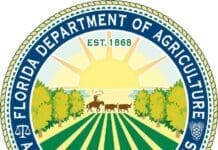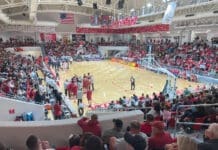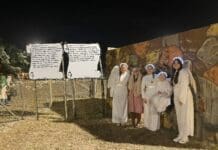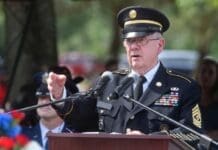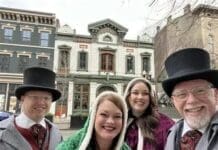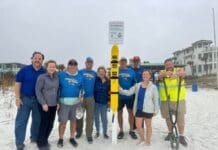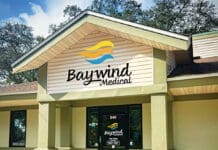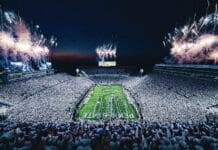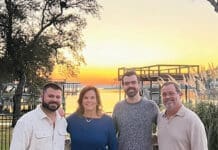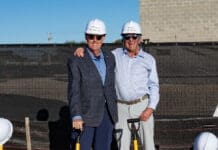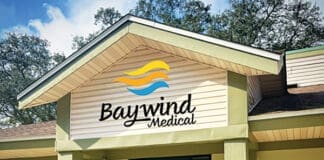By Catherine Card, PIO, OCSD
Two Nasa Astronauts, Colonel Raja Chari and Lieutenant Colonel Robert Hines, stopped by Niceville High School and Bluewater Elementary to speak to Okaloosa County School District students about their experience as astronauts and their journey to become one. ROTC Cadets from Crestview, Niceville, Choctawhatchee and Fort Walton Beach High Schools and students from the Okaloosa STEMM Academy convened at Niceville High School on Thursday, April 13, and the Astronaut Club members from Antioch Elementary and Bluewater Elementary met at Bluewater on Friday, April 14. The astronauts shared a video with the students that showed the primary day-to-day duties and activities they performed on the International Space Station then opened the floor to a Question and Answer session.
 Col. Raja Chari was part of Expedition 66 (October 2021 – March 2022) where crew members conducted experiments that could help identify new materials with innate antimicrobial properties that could be used in designing future spacecraft. New hydrogen sensors were tested on the station’s oxygen generation system to determine their stability over time. Astronauts also manufactured optical fibers in microgravity and contributed to research aimed at improving the infectious disease risk assessment for astronauts.
Col. Raja Chari was part of Expedition 66 (October 2021 – March 2022) where crew members conducted experiments that could help identify new materials with innate antimicrobial properties that could be used in designing future spacecraft. New hydrogen sensors were tested on the station’s oxygen generation system to determine their stability over time. Astronauts also manufactured optical fibers in microgravity and contributed to research aimed at improving the infectious disease risk assessment for astronauts.
Lieutenant Colonel Bob Hines was part of Expedition 67 (March 2022 – September 2022). He and his crew members conducted experiments that studied the aging of immune cells and the potential to reverse those effects during post-flight recovery. A commercial off-the-shelf technology that could help diagnose medical conditions on deep space exploration missions was also tested and sutured wounds heal in microgravity. A new external facility was installed on the orbiting laboratory to map Earth’s dust-producing regions and they conducted an experiment to look at how a new concrete alternative behaves in microgravity could help develop in-situ construction materials on the Moon or Mars.
Lieutenant Colonel Bob Hines was selected by NASA to join the 2017 Astronaut Candidate Class. He reported to the Astronaut Office in August 2017. He has served more than 23 years in the United State Air Force (USAF) as an instructor pilot, fighter pilot and a test pilot. Before his selection in 2017, he was serving as a Research Pilot at NASA’s Johnson Space Center in Houston, Texas. He has accumulated more than 4,000 hours of flight time in 50 different types of aircraft and has flown 76 combat missions in 3 different aircraft types while supporting contingency operations around the world. Hines served as the pilot on NASA’s SpaceX Crew-4 mission to the International Space Station, which concluded on Oct. 14, 2022. The mission was the first spaceflight for Hines. He logged 170 days in space, overseeing the arrival of crew and cargo, maintaining the space station, and conducting science experiments of various disciplines. Hines is familiar with the Emerald Coast and while was assigned to Eglin AFB, his daughter attended Bluewater Elementary School. At Eglin AFB, he served as an F-15C/D/E Experimental Test Pilot and later went on to serve as the first F-15 Developmental Test Program Director with the 84th Test and Evaluation Squadron where he continued to perform flight test on all models of the F-15.
Colonel Raja Chari was selected by NASA to join the 2017 Astronaut Candidate Class. He reported for duty in August 2017. The Iowa native graduated from the U.S. Air Force Academy in 1999 with a Bachelor’s Degree in astronautical engineering and engineering science. He continued on to earn a Master’s Degree in aeronautics and astronautics from Massachusetts Institute of Technology and is a graduate of the U.S. Naval Test Pilot School. He served as commander of the NASA SpaceX Crew-3 mission to the ISS, which launched on November 10, 2021. He served on the International Space Station as part of Expedition 66 and 67 before returning to Earth May 6, 2022, completing the agency’s third long-duration commercial crew mission. The international crew of four spent 177 days in orbit.



